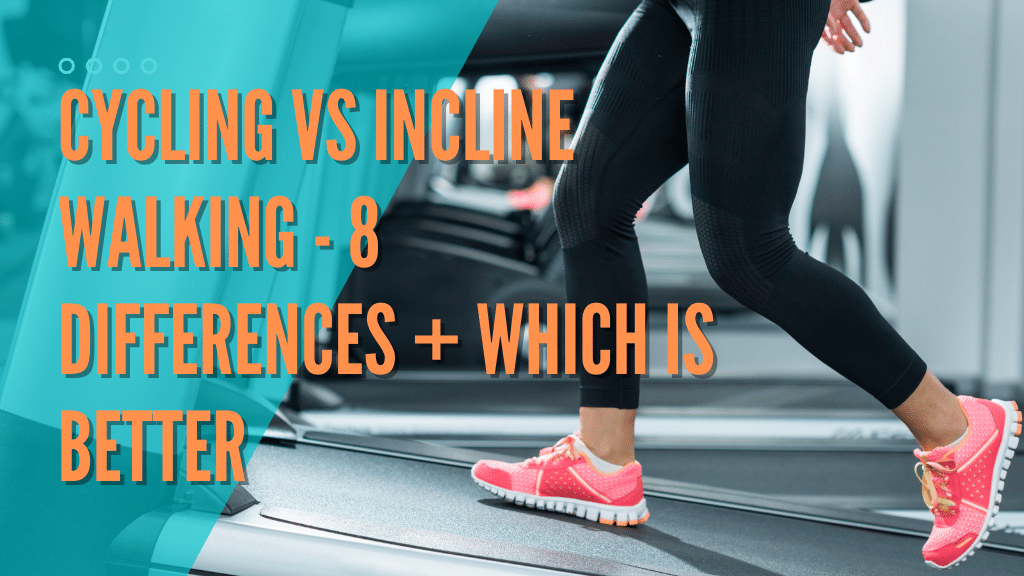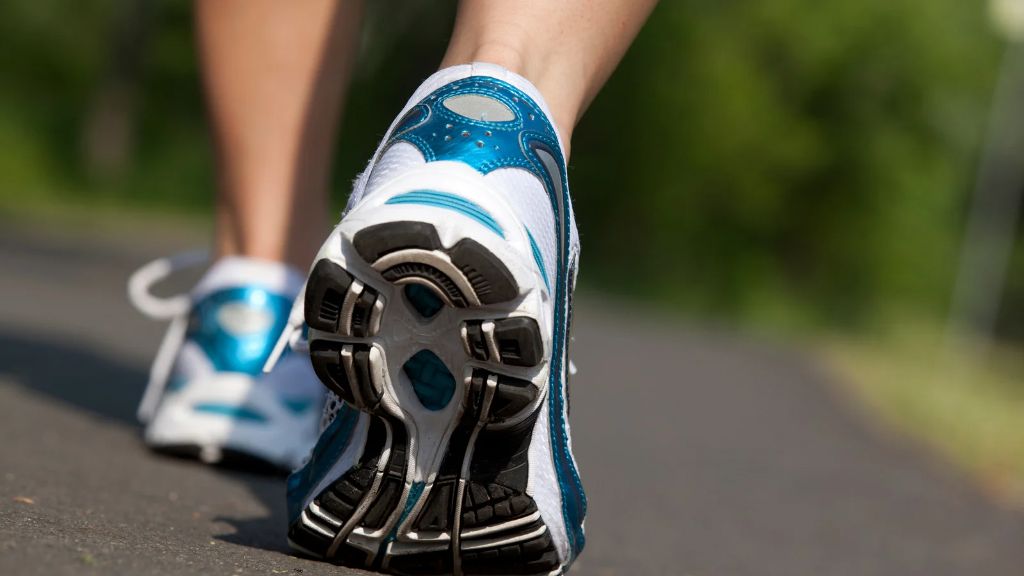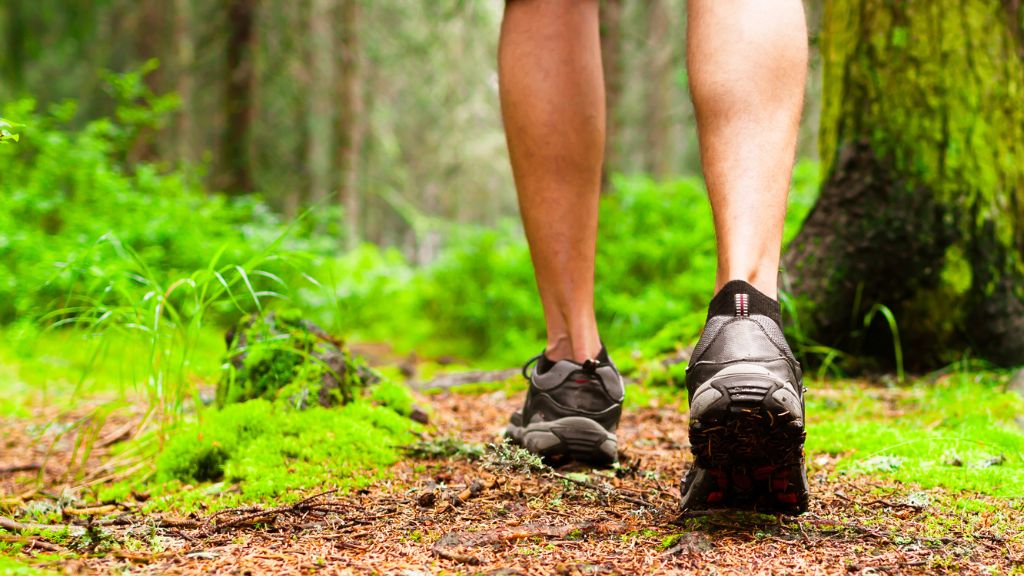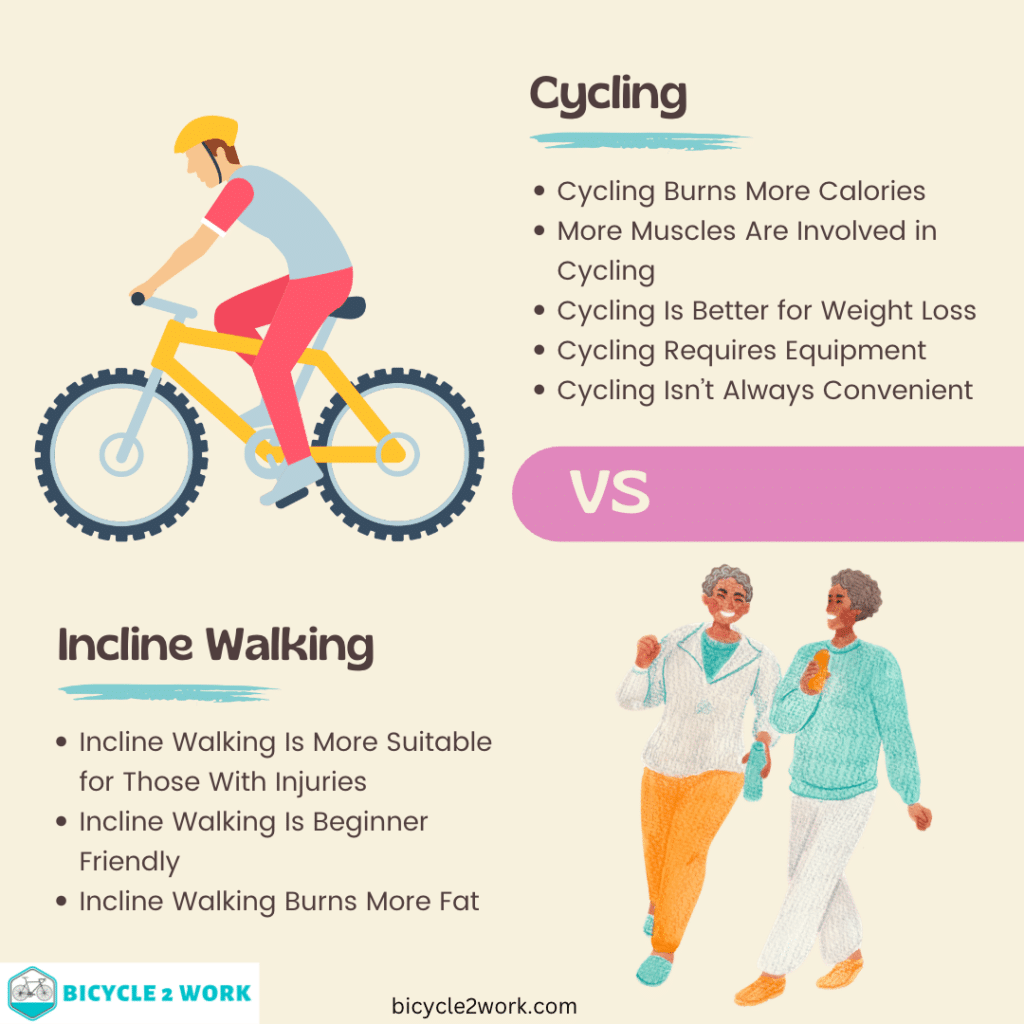This post may contain affiliate links. If you click an affiliate link and make a purchase, I may earn a commission. Also, as an Amazon Associate, I earn from qualifying purchases.--
Incline walking and cycling are well-known aerobic exercises for people of all ages. If you’re looking for a way to stay healthy, you may have wondered which of them is better for you.
This brings us to the question: what are the differences between the two aerobic exercises?
Cycling will serve you better if you aim for more calorie burning and overall more intense exercise Alternatively, incline walking is easier to do and more suitable for those who have injuries or lower back pain.
In this article, we’re going to explore the differences and similarities between cycling vs. incline walking.

What Are the Key Differences Between Cycling and Incline Walking?
Cycling and incline walking offer many positive health benefits while offering less physical strain than many other forms of exercise. For instance, incline walking or cycling every day improves your heart health (source).
Thus, both exercises can help maintain low blood pressure. However, they differ in some aspects. Let’s take a closer look at them:
1. Cycling Burns More Calories
Incline walking is a weight-bearing exercise while cycling isn’t. In weight-bearing exercises, your body is doing all the work. On the flip side, cycling lets the bicycle do some of the work for you.
Even so, a weight-bearing exercise doesn’t always mean that it burns more calories.
The intensity of the activity can change the number of calories you can burn per session.
For instance, a person who walks at 3.5 mph (normal walking speed) can burn approximately 150 calories in a 30-minute session. In comparison, a rider biking at 14 mph (normal cycling speed) for 30 minutes can burn 298 calories.
Here are the number of calories incline walking and cycling can burn in 30 minutes according to the level of intensity:
| Level of Intensity | Incline Walking | Cycling |
| Low Intensity | 154 calories | 240 calories |
| Moderate Intensity | 179 calories | 285 calories |
| High Intensity | 250 calories | 357 calories |
2. More Muscles Are Involved in Cycling
The muscle groups you use in incline walking and cycling are somewhat similar. This includes the gluteal muscles, quadriceps, hamstrings, calves, and core.
Incline walking involves gluteal muscles the more you walk up a steep hill. Yet these muscles become more active when you’re cycling, especially at a faster speed. It’s also worth noting that your muscles need to exert more effort when you’re standing up to pedal your bike.
Other than that, your calves play an important role in both activities. The main reason is that your calf muscles help you propel forward, which is necessary when you’re biking and walking uphill.
However, the quadriceps are more involved in cycling than incline walking. The quadricep muscles allow you to push down on the pedal when you’re cycling.
Overall, cycling requires more muscles and needs more energy. Therefore, it helps you develop more muscle strength.

3. Incline Walking Burns More Fat
Incline walking can burn more fat than cycling, especially when you’re walking up a more steep incline. This is because incline walking requires you to stand on your feet and support your weight.
On the flip side, cycling uses the bicycle as a machine to move and carry your weight during the activity.
4. Cycling Is Better for Weight Loss
Losing weight involves sticking to a healthy diet and increasing your activity levels to burn calories. Based on the table above, cycling burns more calories compared to incline walking.
Hence, cycling is a better choice for weight loss than incline walking.
5. Incline Walking Is More Suitable for Those With Injuries
Injuries might limit the activities you can do to stay active. Luckily, both incline walking and cycling are low-impact exercises that can help you maintain a healthy lifestyle without risking your injury.
However, if you’re already suffering from an injury or a physical issue, incline walking might work better for you.
For example, road cycling may not be suitable for a person with lower back pain. The major reason is that the cyclist needs to maintain a bent position to ride the bike.
On the other hand, incline walking may be suitable for a person with lower back pain because they can stay in a straight posture throughout the activity.
Keep in mind that you should feel comfortable when performing any form of exercise. For instance, you can switch to road cycling if incline walking gives you too much muscle pain.
Consider the type of injury that you have before making a decision. Speak to a doctor and discuss which exercise is best for you.

6. Incline Walking Is Beginner-Friendly
Cycling may not be the best choice if you’re a newbie at cycling. Riding a bike requires quite some practice even if you already know how to balance yourself out.
There will be some instances where you have to ride slowly or stop suddenly, which are things that a new rider may not handle correctly.
In contrast, incline walking doesn’t require balancing yourself on a moving set of wheels. Your feet are on the ground at all times and you can set your own pace.
7. Cycling Requires Equipment
Incline walking and cycling can be indoor and outdoor activities. Both exercises will require equipment if you want to do them indoors.
For instance, you’ll need a treadmill for incline walking. On the other hand, you must have a stationary bike at home if you prefer cycling indoors.
However, you won’t need equipment if you walk outside on uneven terrain. You just need a pair of comfortable shoes and you’re good to go!
On top of that, incline walking outside is a great way to relax and connect with nature.
You may opt for cycling in an indoor and outdoor setting. Either way, you’ll need to invest in equipment.

8. Cycling Isn’t Always Convenient
Cycling can be inconvenient if your town is often crowded with traffic, especially if you commute to work using a bike and consider it your exercise.
Cycling can be challenging if your workplace is far from your house. On top of that, you might need to carry your bike on public transit to get to the place where you can bike.
In comparison, incline walking is hassle-free and can be done anywhere you can walk.
What Are the Similarities Between Cycling and Incline Walking?
Although incline walking and cycling have lots of differences, they also have similar benefits if you perform the activities consistently:
1. Improve Your Heart Health
Incline walking and cycling are excellent ways to increase your heart rate. Typically, your heart is at its lowest rate when you’re at rest.
Then, your resting heart rate rises as you start exercising. Continuous intervals of raising your heart rate act as the gym of your heart muscle. Your cardiovascular health will improve, and your overall endurance will become much better.
In simpler words, you’ll have a lot more energy throughout the day and tire far less.
2. Improve Your Posture
Cycling and incline walking target your posterior chain muscles. The more you walk uphill or pedal harder, the stronger your posterior chain muscles become.
By doing the exercises regularly, you can improve your posture and your overall appearance.
3. Both Exercises Are Eco-Friendly
Replacing your daily transportation option with cycling may help you reduce your carbon footprint. According to studies, riding your bike every day minimizes your carbon footprint by 67% (source).
On the other hand, incline walking is good for the environment as well. Equipment is completely optional. So, you can ditch the treadmill and do the exercise outside.

Cycling vs Incline Walking: Which Is Better?
Incline walking and cycling are both great exercises. However, choosing between the two activities comes down to your preferences.
For instance, cycling can be the best option if you want to burn calories while you commute to work.
On the other hand, you can opt for incline walking if you have back pain.
In the end, trying both activities is the easiest way to determine what exercise suits you best. This way, you’ll know which exercise is more comfortable for you.
Plus, you can also consider which one will fit into your existing routine. Here’s an infographic summarising the differences between the two.

The Wrap Up
There you have it! The key differences between cycling vs. incline walking. Both exercises are an excellent way to lose or maintain a healthy weight.
Incline walking and cycling can burn fats and calories. Yet, cycling sheds more calories even with the same intensity as incline walking.
Cycling might suit you if you don’t have the time to exercise and commute to work by bike. You can burn calories and increase your muscle strength by riding a bike to your workplace.
On the other hand, you can benefit from incline walking if you prefer a weight-bearing exercise. Plus, you can explore the great outdoors!
Whichever exercise you choose, it’s better to opt for an activity that you enjoy the most.
Frequently asked questions
Is 30 minutes of stationary bike the same as 30 minutes of walking?
Both exercises target similar muscle groups. However, in general, cycling burns more calories than walking. This is the case across all levels of intensity.
If you have lower back pain or an injury it is more suitable to walk, as it’s less rigorous than cycling.
Is cycling or treadmill better for belly fat?
A study has found that you exert more energy using a treadmill than other indoor exercise machines (source). Since incline walking/running on a treadmill is a weight-bearing cardio exercise, it is better at burning calories.
However, evidence shows that it is not possible to naturally lose fat only in one specific area ie. the belly (source). You are more likely to burn fat across your entire body; by doing regular physical activity along with a nutritious diet.
How long on stationary bike equals 10,000 steps?
On average, it riding a stationary bike for about 1 hr 15 minutes should be the same as 10,000 steps. However, reaching this should take much less time if you cycle at a moderately fast pace on a stationary bike.
Is 3 miles on a stationary bike the same as walking 3 miles?
You are likely to burn more calories walking over 3 miles than cycling. However, it will take you much longer to reach that by walking over cycling.
